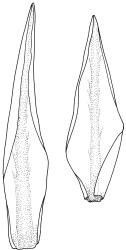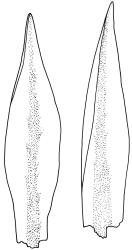- ≡ Campylopus acuminatus var. kirkii (Beckett) J.-P.Frahm, J. Bryol. 14: 702 (1987)
- = Campylopus kirkii var. pilosus Frahm, Lindbergia 7: 30 (1981)
Plants yellow- to brown-green, usually dark brown below, forming dense tufts or turves in wet habitats. Stems (c. 5–)40–100 mm, not or sparsely branched, in cross-section with a central strand, and one to several layers of thick-walled cortical cells; rhizoids absent or sparse. Leaves erect-spreading when moist, somewhat contorted and often weakly rugose when dry, often serially comose, mostly broadly lanceolate, weakly narrowed to insertion, occasionally narrowly lanceolate in some sectors of the shoots, strongly concave to subtubulose, nearly always rounded and cucullate at apex, lacking a hair-point, entire or very weakly toothed in upper half, with c. 10–12 strongly projecting cells at the back of the cucullate apex, weakly bordered, 3.8–4.7(–6.0) × (0.5–)1–1.3 mm; upper laminal cells obliquely oriented, linear-rhomboid, variably porose, mostly 36–75 × 6–9 µm; basal laminal cells incrassate and strongly porose, pigmented (not hyaline), linear-rhomboid to short-vermicular, mostly 45–90 µm; alar cells well differentiated, strongly inflated or occasionally subquadrate, hyaline or pigmented, forming a large, slightly auriculate group, sometimes merging with the lower laminal cells through a small triangular group of non-inflated hyaline cells; marginal cells linear, forming a weak border 1–3 cells wide, extending ± to apex. Costa c. 350–460 µm wide and <60% of the leaf base width, becoming ill-defined and c. 210–230 µm at mid leaf, often with short lateral spurs (especially in broadly lanceolate leaves), percurrent; in both abaxial and adaxial surface view the cells linear; in mid leaf cross-section ill-defined and lacking abaxial ridges, with a single layer of enlarged (c. 10 µm diam.) cells (which could be interpreted as guide cells) usually partially covered adaxially by few to many stereid-like cells, with 1–2(–4) layers of abaxial stereids. Propagulae absent.
Dioicous. Perichaetia leaves strongly sheathing, lanceolate from an oblong base, c. 5 mm. Setae strongly cygneous, c. 10 mm; capsules ovoid, non-strumose, sulcate when dry, c. 2 mm; stomata absent; annulus strongly differentiated, revoluble; operculum short-rostrate from a conic base. Peristome teeth orange and vertically striolate below, hyaline above, split c. half-way to base. Calyptra not seen. Spores 15–18 µm, smooth.
Beckett 1894, pl. 30; Bartlett & Frahm 1983, fig. 7 (as C. kirkii, including some as var. pilosus); Frahm 1987, fig. 1.
Campylopus kirkii is a readily recognisable species growing in a distinctive habitat throughout N.Z. and parts of Australia. It is typified by an ample fruiting collection present in three N.Z. herbaria. On these bases, the application of the name C. kirkii Beckett at the species rank to Australasian material is readily justified. Campylopus acuminatus Mitt. is rejected as a N.Z. species.
Campylopus bicolor var. γ, mentioned by Brown [Trans. & Proc. New Zealand Inst. 29: 472, 1897] has no nomenclatural standing as it is unnamed according to Article 9.1 of the International Code of Nomenclature.
The costal spurs, thick-walled and porose basal laminal cells (extending to insertion or nearly so), and often serially comose nature of the shoots (sectors of broadly lanceolate leaves alternating with more narrowly lanceolate leaves) of C. kirkii serve to prevent its confusion with C. bicolor. The latter species has much stiffer leaves, costae lacking lateral spurs, thin-walled and hyaline basal laminal cells, and non-comose shoots. The nature of the mid costal cross-section also distinguishes the two species.
NI: N Auckland (Te Paki, Mōkaikai Scenic Reserve, Taipā, Ahipara Plateau), including offshore islands (GB), S Auckland, Wellington? (s. loc.); SI: Nelson (Golden Bay, near Wanganui Inlet, Darby Pond, Stockton Plateau, Denniston Plateau, Westport, Charleston), Westland (Lake Hochstetter, Kūmara, Arawhata River and vicinity), Southland; St (Freshwater Flats, Port Pegasus); Ch.
Australasian. Tasmania*. Reported from mainland Australia (Qld, N.S.W., Vic., and S.A.) by Frahm (1994) and from a slightly different range of states by Scott & Stone (1976).
On peat or sand in nutrient-depleted wetlands, often those with hardpan or bedrock impeded drainage such as kauri-gumlands, pākihi, or peatlands developed over sandstone platforms; sometimes submerged. The best-documented North I. collections are from c. 160 (Te Paki) to c. 250 m (Ahipara Plateau), although some material from the vicinity of Cambridge (S Auckland L.D.) appears to be from lower elevations; on the South I. from near sea level (Awarua Bog, Southland L.D.) to 1030 m (Darby Pond) elevation. Campylopus introflexus is a frequent associate.
The variation in N.Z. material is insufficient to justify recognition of more than the single variety.
When well developed, the yellow- to brown-green coloration of the plants, with often comose leaves that are strongly concave to subtubulose and cucullate apically, facilitates recognition. The comose habit is due to leaves of contrasting shape (some more broadly lanceolate) developing on different sectors of the shoots. Microscopically, the costa, which is usually c. 60% the width of the leaf base near the insertion, often gives rise to short lateral spurs (sometimes visible under stereoscope), and in mid leaf cross-section has few to many adaxial stereid-like cells that (in surface view) obscure the larger cells beneath them. Well-developed adaxial hyalocysts occur only in the basal portion of the costa. The basal laminal cells are characteristically incrassate, linear-rhomboid, porose, and non-hyaline; the alar cells are mostly strongly inflated (but sometimes subquadrate) to form a large and slightly auriculate group. Sporophytes are very rare.
The protologue of Campylopus kirkii Beckett cites two syntypes: one collected by T. Kirk on Great Barrier Island, the other collected by Dr L. Boor in Golden Bay (Nelson L.D.). The Kirk syntype is represented in the Beckett herbarium (CHR 564015) by a few sterile plants. The Boor syntype is represented in the Beckett herbarium (CHR 564014) by ample fruiting material; part of this collection is also present at AK and WELT. The illustration in the protologue was executed by Beckett from the Boor syntype. For these reasons the Boor collection was designated as the lectotype by Fife (2019a).
Much uncertainty surrounds the type and status of Campylopus kirkii var. pilosus J.-P. Frahm. The varietal protologue states the type was collected on 14.1.1978 (14 Jan. 1978) at 800 feet elevation in a "swamp near the junction of Kaiiwi Lake and Taharoa Lake" (N Auckland L.D.). However the specimen provided by Frahm to CHR on 14 Feb. 2001 (CHR 540508) as the "original specimen received from John Bartlett" bears notes by Bartlett indicating it was collected on 14.9.1978 at sea level in "Kaiiwi swamp". The vegetative leaves in the bulk of the shoots are bronze-green to nearly black, narrowly linear-lanceolate, c. 6 mm long; exceedingly few leaves are piliferous as illustrated in the protologue (Frahm 1981, fig. 1, 1–2). The costa in cross-section at mid leaf consists of 4–5 layers of mostly incrassate cells with the exposed adaxial layer somewhat enlarged (but not hyaline). No abaxial projections are present. Near the insertion the costae are wider (c. 80% of the leaf width) and more distinctly delimited than those representative of C. kirkii; no lateral spurs are visible. Near the insertion there is a strong layer of enlarged adaxial cells (± hyalocysts) over 3–4 layers of smaller, thick-walled cells; abaxial ridges are lacking. The basal laminal cells are rhombic, thick-walled, and strongly porose, and there is a distinct group of hyaline, inflated alar cells. More significantly, however, there are several broken shoot fragments and at least one intact shoot in which the predominantly linear-lanceolate leaves grade abruptly into broader leaves with ± rounded apices and indistinct, spurred costae. These leaves, including their costal structure and laminal cell detail, agree in every significant way to representative C. kirkii.
A similar gradation from narrowly lanceolate leaves to broadly lanceolate ones with ± rounded apices and laminal and costal structures clearly assignable to C. kirkii occurs in many other herbarium specimens. In no specimen examined are the vegetative leaves as narrowly lanceolate as in the lectotype of C. kirkii var. pilosus. However, the existence of shoots with variable leaf forms in some herbarium specimens (in addition to the lectotype, see L. Visch s.n., 19 Nov. 1990 from Lake Monowai in Southland L.D., CHR 478137 and E.W.E. Butcher s.n. from Moanatuatua Swamp in S Auckland L.D., CHR 105297). The variation in leaf form may be a response to fluctuating water levels. Such material and the presence of representative leaves/shoot sectors in the type of Campylopus kirkii var. pilosus makes the placement of the latter in synonymy inevitable.
Frahm (1987, 1994) subsequently reduced C. kirkii to a variety of the Fuegian C. acuminatus Mitt. [J. Linn. Soc., Bot. 12: 90, 1869], a synonymy that is rejected here. He also (Frahm 1987, 1994) treated his own C. kirkii var. pilosus as a synonym of C. acuminatus Mitt. var. acuminatus and recorded this latter taxon from both N.Z. and Australia.













